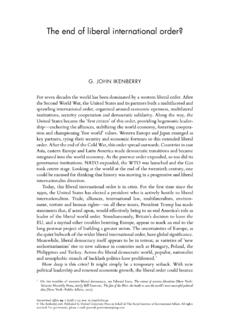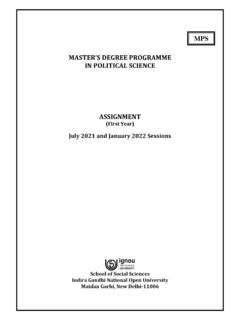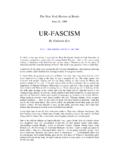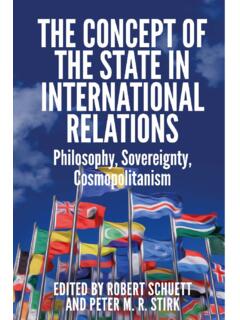Transcription of overview of the far right
1 1 overview of the Far- right Dr Benjamin Lee Centre for Research and Evidence on Security Threats (CREST) Lancaster University, UK This work was funded by the Centre for Research and Evidence on Security Threats (CREST). CREST is commissioned by the Economic and Social Research Council (ESRC Award: ES/N009614/1) with funding from the UK Intelligence Community. 2 Introduction This paper considers the far- right , an overarching term that includes a range of ideologies encompassing both the radical right (democratic) and extreme right (anti-democratic) (Ravndal & Bj rgo 2018). The defining characteristic of the far- right for this paper is: A narrative of racial and/or cultural threat to a native group arising from perceived alien groups within a society.
2 This is considered a working definition intended to bound this paper only, this should not be treated as This paper focuses on the far- right in the United Kingdom. However, far- right activism is transnational, and so it has not been possible to limit this research exclusively to the UK, nor can the UK far- right be considered in isolation from the wider far- right (Z quete 2015). The far- right is not composed only of discrete and easily identifiable groups. While various organisations are components of the far- right , including gangs, protest movements, pressure groups, and political parties, the far- right as a whole is amorphous. Its messiness is inherent, stemming from a diverse range of ideologies and narratives enacted over a wide range of geographic contexts by multiple actors.
3 Adding to this, digital technology has allowed an already complex patchwork of groups, influencers and activists to diffuse further through multiple and sometimes overlapping presences on an array of digital platforms. While some far- right activists may join a local group, activists are also now able to choose from, and contribute to, a limitless range of ideologies and ideologues digitally. It follows that the ideologies and narratives presented here should not be considered as discrete or static, but rather readers should understand that ideas both overlap and crosspollinate across networks both digital and physical. The following outlines the core ideological features of far- right groups and influencers.
4 It then goes on to note some of their aims and objectives before providing an overview of the scale of far- right activism in the UK. 1 A fuller definition of the far- right proposed by Ravndal and Bj rgo (2018: 6) is: acceptance of social inequality, authoritarianism, and nativism. The definition used here focuses on aspects of nativism for the purposes of clarity and the opportunity to emphasise the dichotomy between racial and cultural approaches to belonging found in the far- right . It is also a way of compensating for the increasingly liberal rhetoric emphasised in radical right -wing formations defence of minority rights which, depending on interpretation, could conflict with Ravndal and Bj rgo s inclusion of social inequality as a feature of the far- right .
5 3 Ideology & Narratives Ideology can be considered as the mental frameworks used by individuals to make sense of the world, and encompasses beliefs, ideas and values. Ideology is often implicit and so understanding ideology in far- right groups requires interpretation of the limited data available. As part of this process there is often a gap between how far- right activists view themselves and how their ideas are understood by outside observers (Busher 2018). As a result, terms commonly used to describe different factions within the far- right are often contested. Fascism The starting point for understanding far- right ideology is inter-war fascism as embodied by regimes that came to power in Fascist Italy and Nazi Germany.
6 At its most basic fascism is a palingenetic form of populist ultra- nationalism (Griffin 1991: 26). Palingenesis refers to a belief in the need of renewal and a rebirth. Populist is used in this context as a belief in the role of the mass of people in politics, even where they are led by a vanguard or elite. Ultra- nationalism is used as a label for nationalism that goes beyond existing norms and liberal understandings of the nation to view it as a higher goal in need of protection from both internal and external corrupting influences. The vision of a national community arising from the ashes of crisis is a key mobilising influence in fascism (Griffin 1991: 38).
7 Fascism is also a revolutionary ideology, aiming for wholesale political change with a distinct political vision rather than reforms from within (Griffin 1991: 15; Copsey 2008: 79). While the idea of the nation as both special and in need of defence inevitably leads to a racist component, this is not synonymous with the extreme biological racism and anti-Semitism of the Nazi regime (Griffin 1991: 48). Fascism as an ideological competitor to Communism and Liberalism collapsed in Europe in 1945 but has continued to exert influence since. Neo-Nazism Nazi Germany has become the dominant model for fascism and a range of groups and activists have incorporated elements of Nazism into their ideology (Copsey 2008: 79).
8 In the United States existing white-supremacist groups such as the Ku Klux Klan co-opted Nazi symbols and rhetoric into their existing belief systems (Camus & Lebourg 2017). White-supremacy has come to replace the racial hierarchies of Nazi Germany and the central goal of neo-Nazi organisations has become the territorial separation of whites from other races (Camus & Lebourg 2017). In the UK several groups retain elements of neo-Nazi ideology including the use of Nazi symbols and rhetoric: Combat 18, Blood and Honour, the British Movement, and National Action and successor groups. A further factor has been the embracing of neo-Nazism by some elements within skinhead culture and the white power music scene (Cotter 1999).
9 There is also an extensive reservoir of neo-Nazi infused content online in web forums such as Stormfront and the diffuse online sphere known as the Alt- right (Wendling 2018:130).2 A recent development has been the influence of US-based ideologue James Mason on a small number of militant neo-Nazi groups 2 The presence of neo-Nazis causes chagrin among seemingly more moderate white-nationalist elements within the Alt- right . Wendling uses the example of the Daily Stormer, a neo-Nazi website, to illustrate how a Nazi hardcore at times forces itself to prominence in the Alt- right . 4 including US group Atomwaffen Division and, in the UK, National Action successor System Resistance Network (Macklin 2018).
10 3 Neo-Fascism Neo-Nazism is a highly visible strain of fascism and the memory of the Second World War in Europe, in particular the Holocaust, will always mark neo-Nazis as extremists (Goodwin 2011: 22). The fascist ideological project has continued and ultra- nationalism and rebirth have remained central planks of the ideology but have been re-interpreted to offer something distinct from traditional fascism (Copsey 2008: 82) As an example, the New- right was a French intellectual movement that sought to distance itself from overt racial hierarchies and develop a new approach based instead on While race remains a key organising principle of the ideology it was expressed through differentiation rather than hierarchy.















